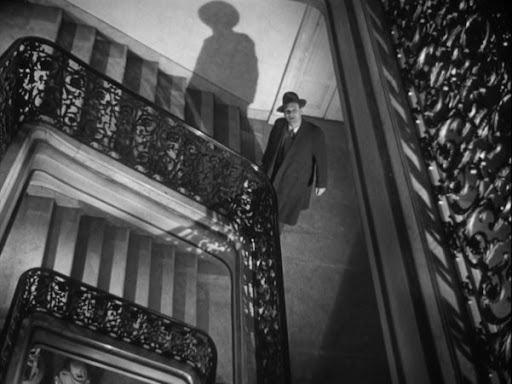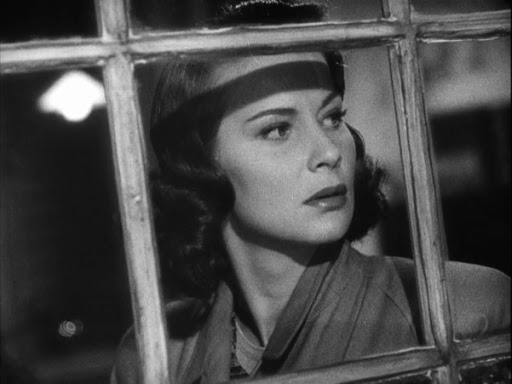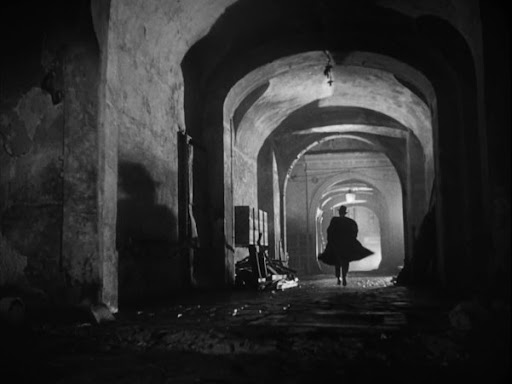
The Third Man is the most beautifully composited films I've ever had the pleasure of viewing. We needed seven screencaps for the readmore, and after close to an hour (and 23 images), I said "screwwwwwwww this...", being that I was only halfway through the film. Then it was Sophie's Choice trying to pick seven perfectly composited moments, when they were all perfect. Only Tarkovsky and Larisa Shepitko can make practically each frame of their films look like high art, but Carol Reed can do so much more with shadows, and this film is a testament to his prowess. Now that The Third Man is in BluRay, his work is even that much more stunning. Enjoy a masterpiece.

From Charles Drazin:
In January 1948, British film producer Sir Alexander Korda, head of British-Lion and London Film Productions, commissioned novelist Graham Greene to write and research “an original postwar continental story to be based on either or both of the following territories: Vienna, Rome.” The resulting script was to be directed by Carol Reed, with whom Greene had just completed a successful collaboration on the film The Fallen Idol.
In February, Greene flew out to Vienna, which had been under the occupation of the Four Powers—France, Britain, the United States, and the Soviet Union—since the end of the war. When he arrived, he already had a skeleton of an idea about a character called Harry who appears to be dead but turns out not to be, but it was the city of Vienna itself, and its history, that put the flesh on this skeleton.
Korda’s representative in Vienna, Elizabeth Montagu, showed the writer around the badly bombed and impoverished city. “I took him everywhere,” she recalled. “I took him to the ruins, I took him to the places still standing, I took him everywhere you can think of, including the Great Wheel and all that. He became absolutely enamored of Vienna.”

As well as showing Greene the sites, Montagu introduced him to people she thought might help him with his research. British military officials explained the black market and the tensions that existed between the Four Powers, while an Austrian journalist, Peter Smollett (né Smolka), told him about the labyrinth of sewers beneath the city and gave him some short stories he had written about the difficulties of life in the contemporary city.
At the beginning of March, Greene traveled on to Italy—not to do further research in Rome, but to write a story that drew on all he had learned about Vienna. Called “The Third Man,” this story would eventually be published as a novella, but its primary purpose was to serve as a film treatment, which Greene delivered to Korda in late April.
In early May, Korda met the American film producer David Selznick in Bermuda, where in the course of a yachting holiday he agreed to a four-film coproduction deal. The arrangement was that Korda’s London Film Productions would make the films, while Selznick would provide Hollywood stars and a proportion of the financing in return for the U.S. distribution rights. The first of these films was to be Reed’s production of Greene’s new story. An important bargaining counter in the agreement, Reed—whom Selznick considered to be “one of the finest picture makers in the world”—had joined the two producers in Bermuda. Here he had an opportunity to discuss with them the detail of Greene’s story.

Disinclined to forgive Selznick’s clearly difficult and overbearing personality, Greene and Reed would many years later caricature him as a philistine movie mogul who had no constructive ideas to contribute, but the evidence suggests that at this early stage he inspired some important changes. A notable example is the memorable ending of the film. According to Reed’s own notes, it was Selznick who argued against the “happy ending” of Greene’s story, in which the hero, Rollo Martins (later changed to Holly Martins), and Anna become a couple after Martins kills Harry Lime: “Selznick felt this very strongly, that Anna’s love for Harry Lime should be fatal, especially since it seems impossible for her to be with Rollo immediately after the shooting of her lover.” Selznick also expressed his view that the character of Anna should be built up, and that Alida Valli, who was one of his contract stars, should play the part.
Reed and Greene worked together on a script that took into account Selznick’s comments, completing a first draft by the end of June. While Korda considered it to be a “tremendous improvement,” Selznick’s confidence was shaken by the negative reaction of his story editor, Barbara Keon, who dismissed the script as “pretty bad” and questioned whether “the story is interesting enough to be told at all.”
Alarmed, Selznick insisted that Greene and Reed come out to see him in Hollywood, and during a series of meetings in August, the pair politely fielded endless suggestions on every aspect of the script. The most pressing of Selznick’s demands was that Martins should be a stronger, more attractive hero whom the audience could root for, instead of the rather forlorn “innocent abroad” Greene had made him. Greene and Reed promised to do their best to accommodate Selznick’s wishes, but in practice quietly disregarded him, relying instead on Korda to fend off the increasingly impatient memos with which Selznick bombarded them in the weeks to come.

The casting of the chief roles took place over the spring and summer of 1948. After reading Greene’s original story in May, Cary Grant had agreed to star, on condition that he could play either of the two male leads, but dropped out in mid-June because he was unprepared to commit himself without a finished script. Reluctantly, Reed accepted Joseph Cotten instead, one of Selznick’s contract stars.
Orson Welles was first put forward as a possibility for Harry Lime at the Bermuda meeting, in May, but Selznick thought his name would damage the film’s box office potential. So over the following months, several other actors were considered too, including Noël Coward, David Niven, Robert Taylor, and Robert Mitchum. Selznick only finally yielded to Reed’s strong preference for Welles in October, just days before the British film crew departed for Vienna.
Location shooting began in Vienna in late October. Cast and crew were based at the Astoria Hotel, in central Vienna, while the Sascha Films studio, in the suburb of Sievering, provided production facilities.
Fearing the heavy snow that might come with the arrival of winter, Reed used three units to save time, each with its own lighting cameraman. Robert Krasker was in charge of the night unit, Stan Pavey the sewer unit, and Hans Schneeberger the day unit. But Reed directed all three, day and night, around the clock.

Welles’s failure to arrive in Vienna on time forced Reed to shoot as many shots as he could using a stand-in. When the actor finally did turn up, he refused to work in the sewers, complaining of the filthy conditions. Reed had no choice but to have a replica of the sewers built at Shepperton Studios, where nearly all of Welles’s scenes, including the famous first appearance in the doorway, would be shot many weeks later.
Perhaps the most providential gift of the trip to Vienna was the discovery of Anton Karas. When the British crew arrived, the head of Sascha Films, Karl Hartl, put on a welcome party. Karas was a little-known zither player who had been hired to provide the music for the evening, but Reed was so struck by the distinctive sound of this strange instrument that he had Karas summoned to the Astoria Hotel for an impromptu audition. Although a conventional orchestral score had already been planned for the film, Reed thought the zither’s catchy sound might serve to add a little local color to some scenes. The last day of location shooting took place on December 11. The production then transferred to British-Lion’s Isleworth and Shepperton studios, close to London. Filming there finally finished the following March.
Once again it was Welles who most tested everyone’s patience. Because he was not prepared to spend more than a week in the studio, all the sets for his scenes had to be built at the same time. But in the manner of the best prima donnas, Welles made up for his tiresome behavior with a compelling performance, which he capped with one moment of brilliant inspiration—his improvisation during the long dialogue scene with Cotten at the Great Wheel, the celebrated cuckoo clock speech: “In Italy, for thirty years under the Borgias, they had warfare, terror, murder, bloodshed . . .”

After the completion of shooting, Reed turned his attention, in April 1949, to the editing of the film, a stage that the painstaking realization of the innovative musical soundtrack much prolonged. A weekly ritual during the filming at Shepperton had been the Wednesday rough-cut night, when Reed would view assemblies of the existing footage. This was the occasion for him to try out Karas’s zither music, which he had recorded in Vienna. Set against some silent sequences in the picture, this music turned out to be so compelling that Reed decided not to have any orchestral score at all, but to use zither music throughout the film. At the end of May, Karas came to London, where Reed put him up in his own house. Every night over the next three months, they ran a rough cut of the picture through a Moviola, Reed managing to communicate the correct dramatic framework and mood for Karas’s compositions although neither spoke the other’s language.
Greene would call Reed “the only director I know with that particular warmth of human sympathy, the extraordinary feeling for the right face for the right part, the exactitude of cutting, and not least important the power of sympathizing with an author’s worries and an ability to guide him.” At every stage of the film’s production, that guidance went hand in hand with an open-mindedness that encouraged his collaborators, whether Greene, Karas, or even Welles, to make some of their most brilliant contributions to the cinema.
On September 2, 1949, The Third Man opened at the Plaza Theatre, in London, to rave reviews. Selznick considered the picture “superb” but still decided to show it to a preview audience in New Rochelle, New York, and tailored the American-release version accordingly, cutting eleven minutes. After repeated postponements because of a bitter dispute between Korda and Selznick over credits, this shortened version finally opened in America, at the Victoria Theater, in New York, on February 2, 1950. Of course, the full, U.K. version is the one included in this release.

Technical Information:
Title: The Third Man
Year: 1949
Country: USA
Director: Carol Reed
Source: BluRay Retail
Video Codec: 1080p x264
Container: .mkv
Size: 7.89 GB
Length: 1:45:13
Programs used: mkvmerge
Resolution: 1440x1080
Aspect Ratio: 4:3
Video: MPEG4 AVC H264 @ ~10400 kb/s
Frame Rate: 23.97 fps
Audio 1: English- Dolby AC3 Mono @ 192 kb/s
Audio 2: Russian overdub- Dolby AC3 Stereo @ 192 kb/s
Subtitles: English, Russian
Thanks to leverage for the original upload!

(Our prefered x264 player is Media Player Classic.)
(Use JDownloader to automate downloading)
The Third Man Megaupload Links


